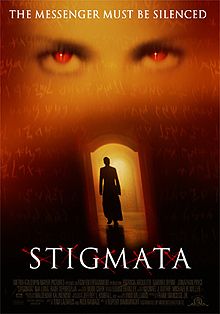 |
 |
 |
 |
September 20, 1999 |
|||||||||||||||||||||||||||||||||||||||||||||||
|
STIGMATA |
|
|||||||||||||||||||||||||||||||||||||||||||||||
|
Frankie Paige (Patricia Arquette) is a 23-year-old beautician in Pittsburgh, who has just received a gift from her mother. It seems that Mom, on one of her trips, purchased a rosary, stolen out of the open casket of a saintly Brazilian priest. His parish has a statue of the Virgin Mary, which has been weeping real blood. Father Andrew Kiernan (Gabriel Byrne, in the pic's best perf) has been sent by the Vatican to investigate this phenomenon. He believes that it is a true miracle, but his findings are rejected out of hand by his superior, Cardinal Daniel Houseman (Jonathan Pryce). Not letting him follow up on the Brazil story, Houseman sends Kiernan to Pittsburgh, to investigate something else. That something else is Frankie Paige, who has now received the Stigmata--visible wounds similar to those suffered by Jesus. There are actually five wounds: wrists, feet, back, forehead, and side. The first known stigmatic was St. Francis of Assisi (1182-1226), who received at most three of the wounds. Kiernan interviews Frankie, but finds that she is an atheist--hardly the holy sort that should be a stigmatic. No matter, she keeps getting the wounds, and in director Rupert Waniwright's best MTV fashion, the audience is treated to numerous quick cut scenes of her suffering. It turns out that this whole business is tied in with a "hidden" gospel that was translated in part by the Brazilian priest, and Cardinal Houseman desperately wants it covered up. In the distorted view of screenwriter Tom Lazarus, a passage saying that "The Church is inside you" is somehow revolutionary and threatens the big bad Vatican. Even though the movie can be (and is) perceived as anti-Catholic, as far as I'm concerned, there's no such thing as bad publicity. What's wrong with piquing the public curiosity about Catholic theological matters? Saying that, we should set the record straight. The Gospel of Thomas, highly touted in Stigmata, has been around for a long time, perhaps since the second century. Contrary to the pic's shrill claim, it has never been hidden. In fact, it was declared non-canonical in fourth century church councils for a very good reason. It is an obvious forgery! Check it out for yourself. Some of the passages merely repeat what is said in the canonical gospels. Other sections are unintentionally humorous mis-statements of canonical material. Most of the rest is either non-sequiturs, or just plain nonsense. I'll provide two examples: (112) Jesus said: Woe to the flesh which depends on the soul; woe to the soul which depends on the flesh (114) Simon Peter said to them: Let Mary go forth from among us, for women are not worthy of the life. Jesus said: Behold, I shall lead her, that I may make her male, in order that she also may become a living spirit like you males. For every woman who makes herself male shall enter into the kingdom of heaven. Catholics can take comfort in noting that whenever Hollywood wants to portray real religious experiences, the Catholic faith is virtually always used. If things are distorted, that's the price of fame, I suppose. The Church's founder said it this way: Many false prophets will arise and deceive many; and because of the increase of evildoing, the love of many will grow cold. But the one who perseveres to the end will be saved. (Matthew 24:11-13)
|
|
|
|
|
Last Update:
|

 One
way to look at this pic is as a rip-off of The Exorcist (1973).
After all, both films deal with Catholic issues in a sensationalistic
manner. Then again, Exorcist was loosely based on a true story,
while Stigmata most assuredly is not.
One
way to look at this pic is as a rip-off of The Exorcist (1973).
After all, both films deal with Catholic issues in a sensationalistic
manner. Then again, Exorcist was loosely based on a true story,
while Stigmata most assuredly is not.
